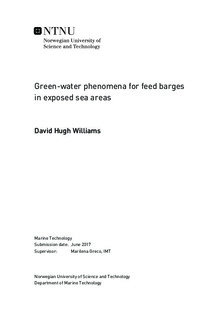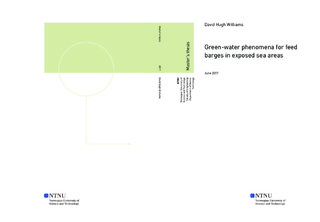| dc.description.abstract | Because of high growth in the aquaculture industry, the feeding barges are moving out to more exposed areas. This brings problems such as water on deck. In this master thesis, a shallow water equation code has been constructed and used to analyse water on deck for feeding barges. The shallow water flow was validated with comparison with theoretical dam break and experimental results, leading to satisfactory results. To simulate water on deck, the code was made in 1-D with a strip method, taking the boundary conditions from the outer domain sea-keeping solver. Two methods were used to give the input to the boundary.
First the RAOs from WAMIT, which is a linear potential sea-keeping solver, were used to make a one way input for the boundary. Using this method, the forces did not affect the motion of the barge. An incident wave amplitude of ζ_a=1 m and wave length to barge length ratio of λ/L=1.3 was used. The flow was analysed and found that the peak force would correspond to the point where the flow stopped going from inflow to outflow conditions. An increase in deck length led to an increase of force, as not all the water could escape between each water shipping period. It also led to a shift in the point to where the maximum force would be found. A convergence test showed small differences in increasing the number of grid points or changing the CFL-number, and 200 grid points and CFL=0.8 was used.
The second method used was FhSim, which is a time domain sea-keeping solver. Diffraction, Froude-Kriloff and radiation forces were taken from WAMIT. The radiation forces were converted to a state space model, such that the model could handle transient effects such as a sudden water on deck. A whole range of frequencies were investigated, both with barge surge motion locked, and with mooring. Transient effects because of phase difference between forces and wave elevation were observed in the beginning of the simulation, which these two methods helped deal with. It was found that the highest forces came at λ/L=1.5 or ω=1.17 rad/s for both methods. The effect of the water on deck on the ship motion was investigated, and it was found very little effect for small wave amplitudes. An increase in the deck length had the same effect as in WAMIT, shifting the peak of the force.
Two different mooring cable weight configurations were analysed, 60 kg/m and 20 kg/m, and it was found that the heavier cable weight led to the transient effects being faster absorbed. The heavier cable did mean the barge was pulled down however, leading to lower margin against water on deck.
A decay test was done in heave, pitch and surge. It was found that the natural frequency of the barge in heave and pitch was ω=1.04 rad/s. The damping in these modes was quite high however meaning the motion died out fast. The forces at these frequencies were found to be lower than the previous frequency, because of the surge velocity being important for the water on deck. The surge decay test with the two mooring configurations showed that the natural frequencies in these modes were so small that realistic waves would not excite them.
Convergence studies with changing the CFL and number of grid points showed small differences. CFL=0.8 and 200 grid points was used with the number of grid points increasing linearly with deck length.
Comparing the results from FhSim and WAMIT, it was found that the forces were much higher in FhSim. The reason for this could be the transient effects, but has to be investigated further.
When increasing the wave amplitude, it was found that the forces from the water on deck helped limit the motion of the barge. This has to do with the maximum peak of the force being delayed to when the barge is moving upwards, meaning it brakes the motion. | |

